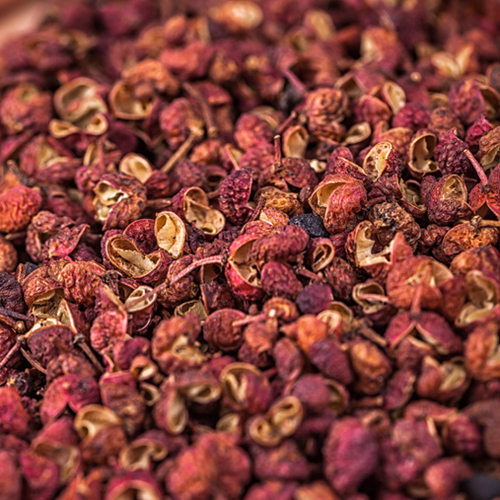
Chinese prickly ash
Scientific names: Zanthoxylum simulans, Zanthoxylum bungei, Zanthoxylum bungeanum
Family: Rutaceae
Alternate names: Chinese Pepper, Flatspine Prickly Ash, Frêne Épineux Chinois, Fresno Espinoso Chino, Hua Jiao, Pimienta China, Red Huajiao, Sansho, Sichuan Pepper, Szechwan Pepper, Szechuan Peppercorn
Background
Chinese prickly ash is a plant. The bark, leaves, and berry are used to make medicine. Be careful not to confuse Chinese prickly ash with ash, or northern or southern prickly ash.
People take Chinese prickly ash to treat pain, nausea and vomiting, diarrhea, and many other conditions, but there is no good scientific evidence to support these uses.
In foods, Chinese prickly ash is used as a spice.
People take Chinese prickly ash to treat pain, nausea and vomiting, diarrhea, and many other conditions, but there is no good scientific evidence to support these uses.
In foods, Chinese prickly ash is used as a spice.
Safety Safety definitions
When taken by mouth: There isn't enough reliable information to know if Chinese prickly ash is safe or what the side effects might be.
When applied to the skin: It is POSSIBLY SAFE to apply small amounts of Chinese prickly ash fruit extract 2% cream to the skin around the eyes for up to 30 days.
Surgery: Chinese prickly ash might slow blood clotting. There is some concern that it might increase the risk of bleeding during and after surgery. Stop using Chinese prickly ash at least 2 weeks before a scheduled surgery.
When applied to the skin: It is POSSIBLY SAFE to apply small amounts of Chinese prickly ash fruit extract 2% cream to the skin around the eyes for up to 30 days.
Special Precautions & Warnings:
Pregnancy and breast-feeding: There isn't enough reliable information to know if Chinese prickly ash is safe to use when pregnant or breast-feeding. Stay on the safe side and avoid use.Surgery: Chinese prickly ash might slow blood clotting. There is some concern that it might increase the risk of bleeding during and after surgery. Stop using Chinese prickly ash at least 2 weeks before a scheduled surgery.
Effectiveness
NatMed Pro rates effectiveness based on scientific evidence according to the following scale: Effective, Likely Effective, Possibly Effective, Possibly Ineffective, Likely Ineffective, Ineffective, and Insufficient Evidence to Rate.
Insufficient evidence Effectiveness definitions
- Aging skin. Early research suggests that using Chinese prickly ash fruit extract 2% cream once a day for 30 days can improve the appearance of wrinkles around the eyes (crow's feet).
- Diarrhea.
- Drowsiness.
- High blood pressure.
- Nausea and vomiting.
- Pain.
- Parasite infections.
- Snakebite.
- Stomach pain.
- Water retention.
- Other uses.
Dosing & administration
The appropriate dose of Chinese prickly ash depends on several factors such as the user's age, health, and several other conditions. At this time there is not enough scientific information to determine an appropriate range of doses for Chinese prickly ash. Keep in mind that natural products are not always necessarily safe and dosages can be important. Be sure to follow relevant directions on product labels and consult your pharmacist or physician or other healthcare professional before using.
Interactions with pharmaceuticals
Medications that slow blood clotting (Anticoagulant / Antiplatelet drugs)
Interaction Rating=Moderate Be cautious with this combination.
Chinese prickly ash might slow blood clotting. Taking Chinese prickly ash along with medications that also slow clotting might increase the chances of bruising and bleeding.
Some medications that slow blood clotting include aspirin, clopidogrel (Plavix), diclofenac (Voltaren, Cataflam, others), ibuprofen (Advil, Motrin, others), naproxen (Anaprox, Naprosyn, others), dalteparin (Fragmin), enoxaparin (Lovenox), heparin, warfarin (Coumadin), and others.
Interactions with herbs & supplements
Herbs and supplements that might slow blood clotting: Chinese prickly ash might slow blood clotting. Using it with other products that have the same effect might increase the risk of bleeding and bruising. These products include angelica, danshen, garlic, ginger, ginkgo, Panax ginseng, horse chestnut, red clover, turmeric, and others. Don't use Chinese prickly ash with any of these.
Interactions with foods
There are no known interactions with foods.
Action
There isn't enough reliable information to know how Chinese prickly ash might work.
vital.ly has licensed monographs from TRC Healthcare.
This monograph was last reviewed on 28/06/2022 18:43:27 and last updated on 09/10/2020 02:48:04. Monographs are reviewed and/or updated multiple times per month and at least once per year.
Natural Medicines disclaims any responsibility related to medical consequences of using any medical product. Effort is made to ensure that the information contained in this monograph is accurate at the time it was published. Consumers and medical professionals who consult this monograph are cautioned that any medical or product related decision is the sole responsibility of the consumer and/or the health care professional. A legal License Agreement sets limitations on downloading, storing, or printing content from this Database. No reproduction of this monograph or any content from this Database is permitted without written permission from the publisher. It is unlawful to download, store, or distribute content from this site.




